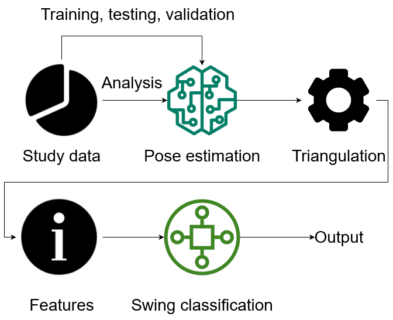ID 2361: AI-driven coaching for golf swing improvement
Master’s Thesis / Research Internship / Student Assistant
The golf swing is arguably one of the most complex whole-body movements in sports [1]. It requires significant physiological effort and precise neuromuscular control to accelerate the clubhead to more than 160 km/h in one-fifth of a second [2]. This complexity requires dedicated training and coaching feedback in order to improve the swing outcome, which is typically defined by direction precision as well as stroke length. However, despite the sports’ popularity (golf is an Olympic sport again since the 2016 games, the German golf association counts about 640000 members), a plethora of existing training material (amazon.de features about 4000 books for “golf training”), and lots of apps for “AI based golf coaching” (e.g., “Golf AI App”, “Swing AI”), there is little scientific material available as to what might constitute an efficient, data-driven method for golf swing improvement.
Such data-driven methods could be all the more powerful and effective, because:
i) current “human” coaching approaches are often subjective and
ii) focus on guiding the player towards an “optimal” movement, where this “optimal” movement is frequently not realistic to be conducted especially by average individual players. This is because a large number of possible errors exist (e.g. wrong swing plane, “closed” club face, biomechanical timing effects) that can lead to a sub-optimal result. It is hypothesized that in this particular error space, there exist errors that lead to a substantial outcome improvement and that are at the same time “simpler” to be addressed by individual non-expert players than others.
The purpose and work plan of this thesis is therefore to analyze the current literature, app market, and patents regarding measurement, data-driven analysis, and feedback coaching to improve the golf swing
- (optionally) conduct expert interviews regarding effective swing improvement approaches
- propose an AI-based coaching architecture that is cognizant of possible errors and ranks these errors by their addressability
- implement a feedback training system for a realistic selection of these possible errors, ideally based on individual necessities and preferences
- propose and conduct a study with at least 2 participants to investigate the effect of this feedback training.
The required movement patterns can already be recorded with high accuracy. The current gold standard is 3D kinematography [3], however, single-view video [4] and inertial measurement units [5,6] have also been employed. There is also parallel research at FAU [7] and also internationally [8] regarding the use of radar- and other EM-wave-based sensing for movement analysis. For this thesis, swing data from a collaboration partner is available for the data analysis part. The required performance information for the feedback study can either be acquired by manual single-view video or using results of a second parallel Master thesis (“AI-driven biomechanical golf swing analysis”). The vision of these theses projects is to contribute to research and development of, in the long run, an AI-driven feedback training system to improve the swing of individual golfers.
The thesis must contain a detailed description of all developed and used algorithms as well as a profound result evaluation and discussion. The implemented code has to be documented and provided. An extended research on literature, existing patents and related work in the corresponding areas has to be performed.
[1] A. McHardy, H. Pollard. Muscle activity during the golf swing. British Journal of Sports Medicine 39, 799-804, 2005.
[2] M. H. Cole, P. N. Grimshaw. The biomechanics of the modern golf swing: implications for lower back injuries. Sports Med 46, 339–351, 2016.
[3] B. M. Nigg, G. K. Cole, I. C. Wright. “Optical methods”, in: Biomechanics of the musculo-skeletal system, B. M. Nigg and W. Herzog Eds., 3rd ed. New Jersey, NJ, John Wiley & Sons, ch. 3.6, 302-331, 2007.
[4] R. Urtasun, D. J. Fleet, P. Fua. Monocular 3–D Tracking of the Golf Swing. Proceedings of the Computer Vision and Pattern Recognition Conference, 932-938, 2005.
[5] R. Burchfield, S. Venkatesan. A Framework for Golf Training Using Low-Cost Inertial Sensors. In Proc. of the BSN 2010, Singapore, 267–272, 2012.
[6] U. Jensen, P. Kugler, F. Dassler, B. Eskofier. Sensor-based Instant Golf Putt Feedback. In Proc. of the IACSS 2011, Shanghai, 49–53, 2011.
[7] www.empkins.de, accessed 26.6.2021.
[8] F. Adib, C. Hsu, H Mao, D. Katabi, F. Durand. Capturing the Human Figure through a Wall. ACM Transactions on Graphics. 34(6), 1–13, 2015.



